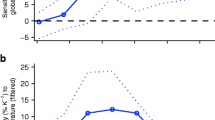Summary
In Part I of this paper series, the dynamic equations, numerical solution procedures and the parameterizations of subgrid-scale and PBL turbulence of the Advanced Regional Prediction System (ARPS) were described. The dynamic and numerical framework of the model was verified using idealized and real mountain flow cases and an idealized density current. In this Part II, we present the treatment of other physics processes and the related verifications.
The PBL and surface layer parameterization, the soil model and the atmospheric radiation packages are tested in a fully coupled mode to simulate the development and evolution of the PBL over a 48-hour period, using the Wangara day-33 data. A good agreement is found between the simulated and observed PBL evolution, at both day and night times.
The model is used to simulate a 3-D supercell storm that is well documented in previous literature. The results show that considerable errors can result from the use of conventional non-conservative advection schemes; the ice microphysics option coupled with a monotonic advection scheme yields the most realistic simulation with better prediction of precipitation.
The ARPS is also applied to the 48-hour prediction of a January 1999 case that involves an outbreak of a historical number of tornadoes for the month within the state of Arkansas, the United States. A long-lasting intense squall line developed following the tornado outbreak. Simulation on 32-km and 6-km resolution grids successfully reproduced the observed development and evolution, including the timing and location, of these systems. Preliminary analyses show that large-scale forcing provided the primary focusing mechanism in triggering the initial convection in Arkansas before the outbreak of tornadic thunderstorms. It is also found that the mesoscale circulation induced by the intense long-lived squall line at the later time contributed significantly, through vertical momentum transport and geostrophic adjustment processes, to the intensification and northward propagation of upper-level jet core, which in term influenced the evolution of surface cyclone and associated precipitation. This last set of experiments serves to demonstrate the capabilities of the ARPS as a complete system in an NWP setting. The result of these experiments and those presented in Part I establishes the credibility of the model for a wide range of applications.
Similar content being viewed by others
Author information
Authors and Affiliations
Additional information
Received April 14, 2000 Revised July 17, 2000
Rights and permissions
About this article
Cite this article
Xue, M., Droegemeier, K., Wong, V. et al. The Advanced Regional Prediction System (ARPS) – A multi-scale nonhydrostatic atmospheric simulation and prediction tool. Part II: Model physics and applications. Meteorol Atmos Phys 76, 143–165 (2001). https://doi.org/10.1007/s007030170027
Issue Date:
DOI: https://doi.org/10.1007/s007030170027




